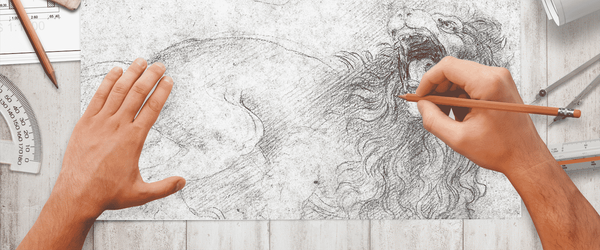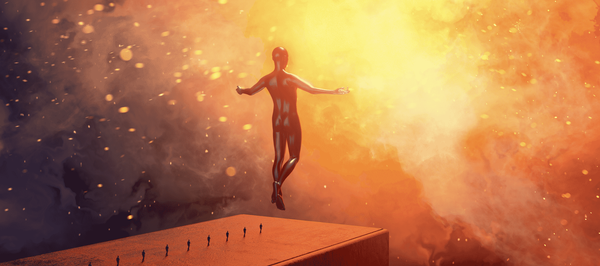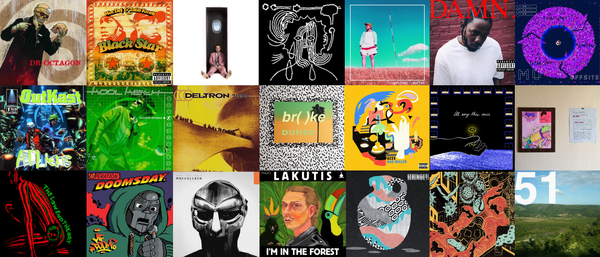Jon Brooks • • 18 min read
9 Sketching Techniques Leonardo da Vinci Used To Achieve Artistic Mastery

Leonardo da Vinci needs no introduction from me.
Nearly everything that can be said of him, has already been said…
Some claim he was a superhuman genius polymath with an IQ of 210, five hundred years ahead of his time.
Others say that he was an opportunistic idea thief, only modifying the designs of the better inventors that came before him.
A few even believe that he was a prophet and left hidden symbols, codes, and upside down animal shapes in his paintings (that’s a topic for another post…or not).
But whatever you think of Leonardo da Vinci’s place in histories’ list of top IQs, there’s one thing that’s agreed upon by both the conspiracists and skeptics alike.
The man was a damn good artist.
So damn good, in fact, many art historians (and artists) have brandished him with the title of ‘the most technically gifted artist that’s ever walked the earth.’
Not bad, eh?
The Da Vinci Talent Code
While it would be foolish to argue that Da Vinci’s artistic talents were not in some way down to his genetics – i.e. some people have better visuospatial cognition than others – it would be just as foolish to argue that his environment did not play a huge role either.
Leonardo was born an illegitimate child (bastard), which made his career options limited to say the least. He was not allowed entry into universities or to continue in his father’s noble profession as a notary.
Rather than simply accept this exclusion, he decided to use it is as creative fuel in an intellectual rebellion that would go on to shape the rest of his life.
So what I can’t go to university, they don’t know everything anyway. I would rather learn from nature and from experience than some boring professor.
As a young boy Leonardo began taking paper from his father’s office, which was very expensive at the time, and go out into the woods to make drawings of plants and animals.
It was these drawings that Leonardo’s father showed to his artist friend Andrea del Verrocchio, who at the age of about fourteen, Leonardo joined as an apprentice artist.
The bad hand society had dealt Da Vinci, it could be argued, was one of his greatest gifts. It gave him an uncomfortable chip on his shoulder that spurred him to constantly challenge and surpass the commonly held ideas of groupthink.
“I have removed the skin from a man who was so shrunk by illness that the muscles were worn down and remained in a state like thin membrane…”
In the wonderful book ‘The Talent Code‘, the author, Daniel Coyle delves deeply into the science of what makes people like Leonardo “tick.”
“It seems almost impudent to presume that we can draw useful lessons from the Renaissance—the hotbed of all hotbeds. After all, we’ve been conditioned to think of Michelangelo, Da Vinci, Raphael, Botticelli et. al. as quasi-divinities—the ultimate natural geniuses of the art world.
But in fact, every one of those “divinities” were once seven-year-old kids, learning skills just like any other kid. While we obviously can’t recreate the combination of cultural/religious/historical forces that set the stage for the Renaissance (not to mention parents who enjoy sending off their seven-year-old to work full time as a painter’s apprentice instead of school), but we can do something just as powerful. We can look at the behaviors and methods—at the combination of deep practice, ignition, and master coaching—that systematically built some of the finest skill-circuits the world has ever seen.”
Coyle discovered that when we practice a skill, an insulator-like substance called myelin thickens around our neural circuitry, which in turn makes us more talented.
More Myelin = More Talent
The type of practice one engages in is the determinant of how quickly our myelin sheaths thicken around our neural circuits.
Good practice, Coyle explains, must test us and stretch our abilities right up to the edge of frustration. Talent without the motivation to ceaselessly improve will never lead to mastery.
So that brings us to the question…
How did Leonardo practice his art?
What sketching techniques did he use to ‘stretch’ his abilities?
As a fellow artist and somewhat of a Da Vinci nerd, I’ve searched through countless Da Vinci notebooks and biographies for these answers.
Listed below, are the results of that search.
Da Vinci himself, and his students used the following 9 sketching techniques repeatedly. They are meant to challenge you and stretch your drawing capabilities.
They are not intended for the creation of pretty pictures. They are exercises. Training. Practice. Work. Treat them as such.
1. Draw Moving Objects
There were no cameras or Internet back in the renaissance so Da Vinci didn’t get his subject matter from Google images. He drew from life.
But Da Vinci being Da Vinci took this ‘sketching from life’ a step further than most. He drew water, storms, birds, running horses, faces in the midst of angry outbursts and groups of laughing men.
In the best biographic portrait of Leonardo, Serge Bramly, on the rapidity Leonardo cultivated by such practice:
“Observing and drawing (and imagining or reflecting) were operations that very soon for Leonardo became much the same thing. Hand, eye, and brain became coordinated through determined training. He gradually turned himself into a sort of living, thinking, and inventive camera (he wrote of “becoming like a mirror” – an intelligent and critical mirror). Drawing seems to have been almost second nature to him. He saw to perfection, then judged and reproduced the subject, seemingly without an intermediary between retina and paper: his thought was formed in the movement of his hand as his hand interpreted his vision. He could work so fast that one sometimes feels one is looking at a form of shorthand.”
Because we cannot depict every detail of the world around us, good drawings, one could argue, are simply the result of a series of decisions made by the artist about what to include, and what to leave out.
“Art is the elimination of the unnecessary,” Picasso famously said.
There is no better way of training yourself to eliminate the unnecessary and notice the most important elements of a particular object, than by drawing it while it’s on the move.
Da Vinci, knowing this, instructs fellow artists to:
“Keep a sharp lookout, for figures in movement, in the streets, in the squares, in the countryside, and note down the main lines quickly: that is to say, putting an O for the head and straight or bent lines for the arms and the same for legs and trunk; then when you get home, look back at your sketches and give them finished form.”
Some of Da Vinci’s anatomical drawings are still used in many medical schools, as references to this day. His study of the human spine is one of the best anatomical drawings ever created.
The astonishing attention to detail Leonardo possessed wasn’t a gift from god, rather a skill cultivated by sketching techniques just like this one found in a note he left himself:
“Tomorrow make some silhouettes out of cardboard in various forms and throw them from the top of the terrace through the air; then draw the movements each makes at the different stages of its descent.”
Do as Leonardo instructs. Go to a bustling place and make quick notes of the people going about their business. Go to a park and draw the birds or the ripples of a lake. Watch a gymnast or a wrestler on YouTube – without pressing pause. Draw moving objects.
2. Copy From The Master
Leonardo was an assistant artist to Andrea Del Verrocchio for roughly 10 years. Back then artists were not so precious over their work as they are now.
It was quite common for assistants to learn their trade by painting small sections of their master’s paintings such as shrubbery or sky and work their way up.
However, if their painting style was too incongruent with their master’s then the piece would look wrong (think Van Gogh doing the scenery in the Mona Lisa). In order to avoid this problem, students would spend a good deal of their time copying their master’s work. Not only was it great practice in it’s own right, it was good for business. Verrocchio’s style is very present in Leonardo’s early paintings.
Leonardo, later in life, would often instruct his own pupils to copy his drawings, in the same way that he had copied Verrocchio’s.
“The artist ought first to exercise his hand by copying drawings from the hand of a good master. And having acquired that practice, under the criticism of his master, he should next practise drawing objects in relief of a good style, following the rules which will presently be given.”
Recently it was discovered that while Leonardo worked on his most famous painting, The Mona Lisa, a student of his, with his own canvas, copied along with him; stroke for stroke.
Both are highly finished paintings of extremely high quality but if a picture says a thousand words, this comparison is an essay on just how skilful a painter Leonardo was.
“The youth should first learn perspective, then the proportions of objects. Then he may copy from some good master, to accustom himself to fine forms. Then from nature, to confirm by practice the rules he has learnt.”
Choose four Leonardo drawings that look difficult and copy them in the same medium they were drawn in. After this, draw from life incorporating the ‘rules’ you have learnt from this technique.
3. Play Perspective Games
The act of turning self-improvement into a game (gamification) is hugely popular nowadays. Whether you want to get fitter or learn a new language, there’s a gamified app that can fulfil your needs.
Leonardo, it probably won’t surprise you, was also a huge fan of gamification when it came to art. Perhaps he really was 500 years ahead of his time?
“When, Oh draughtsmen, you desire to find relaxation in games you should always practice such things as may be of use in your profession, by giving your eye good practice in judging accurately of the breadth and length of objects. Thus, to accustom your mind to such things, let one of you draw a straight line at random on a wall, and each of you, taking a blade of grass or of straw in his hand, try to cut it to the length that the line drawn appears to him to be, standing at a distance of 10 braccia; then each one may go up to the line to measure the length he has judged it to be. And he who has come nearest with his measure to the length of the pattern is the best man, and the winner, and shall receive the prize you have settled beforehand…such games give occasion to good practice for the eye, which is of the first importance in painting.”
He was constantly testing and stretching his visual perspective skills even when he wasn’t drawing. As Michelangelo said “An artist paints with his brains, not his hands.”
Playing perspective games is an incredible drawing exercise. I have modified Leonardo’s approach into something slightly more practical but no less testing:
Take a ruler and mark off the exact number of centimes you estimate an object to be, while standing 10 feet away from it. Challenge friends and family in a game.
READ: The Modern Da Vinci’s 5 Rules of Success
4. Draw Both The Divine And The Grotesque
While we now think of Da Vinci’s work as things of divine beauty, a few centuries ago, they were infamous for the exact opposite reason.
In the Victorian era all around Europe, these ‘grotesque’ heads, as they came to be known, were Leonardo’s most reproduced pieces of art.
Did he have some strange fascination with strange looking people?
If one were to read the work of Vasari, Leonardo’s earliest biographer, one might think so:
“Leonardo was so pleased whenever he saw a strange head or beard or hair of unusual appearance that he would follow such a person a whole day, and so learn him by heart, that when he reached home he could draw him as if he were present.”
Luckily, Da Vinci provides a hint at his reasons for producing these drawings in his notebooks. And in typical Da Vinci fashion, it’s rooted in artistic self-improvement:
“The painter should aim at universality, because there is a great want of self-respect in doing one thing well and another badly, as many do who study only the [rules of] measure and proportion in the nude figure and do not seek after variety; for a man may be well proportioned, or he may be fat and short, or tall and thin, or medium. And a painter who takes no account of these varieties always makes his figures on one pattern so that they might all be taken for brothers; and this is a defect that demands stern reprehension.”
Da Vinci, the polymath that he was, saw no value in doing just one thing well. “The artist holds the universe in his mind,” he often wrote.
Drawing and painting was a self sustaining curiosity factory for Da Vinci. His need to depict the world accurately drove him to study everything in it. And the conclusions he made were tested in the result of his finished work.
Do not doubt that Leonardo was thinking of the sinews and the nerves and the ligaments and the skeletons of the people he had dissected, while he was working on The Mona Lisa.
“Nor is the painter praiseworthy who does but one thing well, as the nude figure, heads, draperies, animals, landscapes or other such details, irrespective of other work; for there can be no mind so inept, that after devoting itself to one single thing and doing it constantly, it should fail to do it well.”
Draw obese people; slim people; muscular people; landscapes; strange animals; things you are not accustomed to drawing. It will make you better at drawing the things you wish to excel at.
5. Fix Things In Your Mind Through Drawing
To illustrators and conceptual designers the ability of being able to draw well from one’s head is essential. To Fine Art students, however, this practice has become somewhat of a lost art form.
This is a shame…
Do you really think Michelangelo had a model in every position in the exact right lighting as a reference for every person depicted on the Sistine Chapel ceiling?
And do you really think the model in The Mona Lisa posed for Leonardo for the 7 years it’s estimated it took him to complete?
Of course not.
I’m sure if they could have worked from photographs and models they would have. It’s easier and it’s faster. But because they didn’t have that option, they were forced not to learn anatomy, lighting and perspective, but to master it.
Renaissance artists internalized the visual alphabet and learnt how to paint stories with it. They transcended copying and became creators.
“Creativity feeds on limitations.”
Leonardo would learn and test his ability to fix objects in his mind like this:
“When you want to know a thing you have studied in your memory proceed in this way: When you have drawn the same thing so many times that you think you know it by heart, test it by drawing it without the model; but have the model traced on flat thin glass and lay this on the drawing you have made without the model, and note carefully where the tracing does not coincide with your drawing, and where you find you have gone wrong; and bear in mind not to repeat the same mistakes. Then return to the model, and draw the part in which you were wrong again and again till you have it well in your mind.”
Repetition is an essential part of mastering any skill. No musician or athlete or surgeon or hairdresser or skateboarder could ever reach a high level without practicing the same drill over and over again.
Art is no different, and Da Vinci knew it. He too, was a very accomplished lyre player. Perhaps he took the learning strategies he picked up from playing the lyre and applied them to art.
In the same way that a concerto pianist will have C scales and D minor chords stored up in their head, ready to come out at a moments notice. Da Vinci had noses, and postures and animals up in his:
“If you want to acquire facility for bearing in mind the expression of a face, first make yourself familiar with a variety of [forms of] several heads, eyes, noses, mouths, chins and cheeks and necks and shoulders: And to put a case: Noses are of 10 types: straight, bulbous, hollow, prominent above or below the middle, aquiline, regular, flat, round or pointed. These hold good as to profile. In full face they are of 11 types; these are equal thick in the middle, thin in the middle, with the tip thick and the root narrow, or narrow at the tip and wide at the root; with the nostrils wide or narrow, high or low, and the openings wide or hidden by the point; and you will find an equal variety in the other details; which things you must draw from nature and fix them in your mind.”
Find a photograph of an object and copy it a few times. When you start feeling confident, try and draw it from your head. When finished, compare it to the photograph and make a note of the differences. Repeat until you can draw it from your head perfectly (or there about).
6. Draw In The Company Of Others
Many artists have no problem showing people their favourite finished pieces; few the processes that made them.
Creativity is a messy practice. The first drafts of the best novels are often ugly and the initial sketch an artist lays down on canvas, often uglier.
Leonardo urges us not only to embrace the uncomfortable feeling one gets when a drawing doesn’t go to plan, but to showcase it to the world:
“I say and insist that drawing in company is much better than alone, for many reasons. The first is that you would be ashamed to be seen behindhand among the students, and such shame will lead you to careful study. Secondly, a wholesome emulation will stimulate you to be among those who are more praised than yourself, and this praise of others will spur you on. Another is that you can learn from the drawings of others who do better than yourself; and if you are better than they, you can profit by your contempt for their defects, while the praise of others will incite you to farther merits.”
Good artists care more about the quality of their work than the frailty of their ego. Good artists are pragmatic. They view all set backs and criticisms as opportunities and feedback to improve with:
“Certainly while a man is painting he ought not to shrink from hearing every opinion. For we know very well that a man, though he may not be a painter, is familiar with the forms of other men and very capable of judging whether they are hump backed, or have one shoulder higher or lower than the other, or too big a mouth or nose, and other defects; and, as we know that men are competent to judge of the works of nature, how much more ought we to admit that they can judge of our errors; since you know how much a man may be deceived in his own work.”
Find a family member or friend and ask them if they’ll watch you draw. Tell them that you’re bad at drawing in front of other people and you think the challenge of doing so will help advance your artistic skills. Ask them to pick out faults and problems with your drawing as you go. Nine times out of ten you will have already noticed the problem, but the one time you didn’t… that’s the lesson.
To see how Leonardo used mirrors to gain objectivity over his work see this article.
7. Draw Drapery
Leonardo spent countless hours in his apprentice days drawing and painting drapery. It teaches one the importance of patience, light values and structure like nothing else can.
Drawing drapery is just as challenging (if not more) as drawing a nude model. The added benefit is that drapery doesn’t move or charge by the hour.
Place a single coloured blanket or curtain over a chair. Set up your light source so that it doesn’t constantly change and draw. Oh, and take your time…
“Many are they who have a taste and love for drawing, but no talent; and this will be discernible in boys who are not diligent and never finish their drawings with shading.”
8. Draw The Same Thing From Multiple Angles
I remember asking my old art teacher once, “Why is drawing from photographs not as a good as drawing from life?” He replied, “Because you can’t look behind a photograph.”
I was young at the time and didn’t really understand what he meant. Why would I want to look behind what I’m drawing? I’m only drawing the front.
My art teacher, like Da Vinci, understood that a good artist doesn’t just copy.
A good artist simplifies, deconstructs, reinterprets, and understands his subject matter.
Many of the worlds greatest portrait painters openly admit that the better their personal connection with the person they’re drawing, the better the finished portrait will be.
All our eyes see is raw jumbled light. Our brain takes this light and sorts it out into objects with form and texture.
Sketching things from multiple angles makes our brains better interpreters of light.
Children draw what they think something looks like; amateur artists copy what they see; master artists draw what they understand.
Sketch a person from multiple angles. Imagine you need to make a record of how they look but you have no camera at hand. Even though you’re using different viewpoints, there should be a basic likeness between them all.
9. Draw In Your Mind’s Eye
Leonardo wasn’t just an artist who could shade well and draw clean lines. He placed just as much emphasis on the composition and content of his art as he did it’s technical rendering.
The triangular composition, the eye lines, and the curved centreline which extends into a finger pointing to the heavens, were all carefully chosen by Leonardo to tell a story.
For centuries artists have experimented with drugs for inspiration, but this was not Da Vinci’s style. He had a cleaner, albeit stranger, method:
“I cannot forbear to mention among these precepts a new device for study which, although it may seem but trivial and almost ludicrous, is nevertheless extremely useful in arousing the mind to various inventions. And this is, when you look at a wall spotted with stains, or with a mixture of stones, if you have to devise some scene, you may discover a resemblance to various landscapes, beautified with mountains, rivers, rocks, trees, plains, wide valleys and hills in varied arrangement; or again you may see battles and figures in action; or strange faces and costumes, and an endless variety of objects, which you could reduce to complete and well drawn forms. And these appear on such walls confusedly, like the sound of bells in whose jangle you may find any name or word you choose to imagine.”
Our minds are natural hallucinators. When we lack external sensory input our brains manufacture their own. This phenomenon can be seen in full effect with the use of sensory deprivation chambers.
If you don’t have one of these, a bedchamber will suffice.
“I myself have proved it to be of no small use, when in bed in the dark, to recall in fancy the external details of forms previously studied, or other noteworthy things conceived by subtle speculation; and this is certainly an admirable exercise, and useful for impressing things on the memory.”
For inspiration deprive your mind of interesting stimulation so it comes up with it’s own. Stare at a stained wall, the clouds, into space or close your eyes and let your mind wander. Design a composition with the results of this exercise.
Sketching Techniques from Leonardo da Vinci Final Thoughts
The ability to draw technically well is like a guitar player who can play extremely fast. It’s an added string to your bow.
What really counts is the ability to move people, to present ideas and questions that stir up our emotions. But, the problem is that artists who lack any technical ability will struggle to communicate their ideas to their full effect. We need to be able to do both. Remember:
“The painter should aim at universality, because there is a great want of self-respect in doing one thing well and another badly…
I’ll leave you with some final words from Serge Bramly on the end result one can expect to achieve if they work hard at Leonardo’s sketching techniques:
“In his studies of flowers, bodies, machines, and whirlpools, depicted in the minutest detail, or of birds in mid-flight, he finally achieved a mastery comparable to that of Zen archers who have come to identify so clearly with their weapon and its target that his arrows hit it without their having consciously taken aim.”
Find your target.
Take aim.
DRAW.
This post is republished with permission of the original author.
This original can be found at ComfortPit.com

Jon Brooks
Jon Brooks is a Stoicism teacher and, crucially, practitioner. His Stoic meditations have accumulated thousands of listens, and he has created his own Stoic training program for modern-day Stoics.










